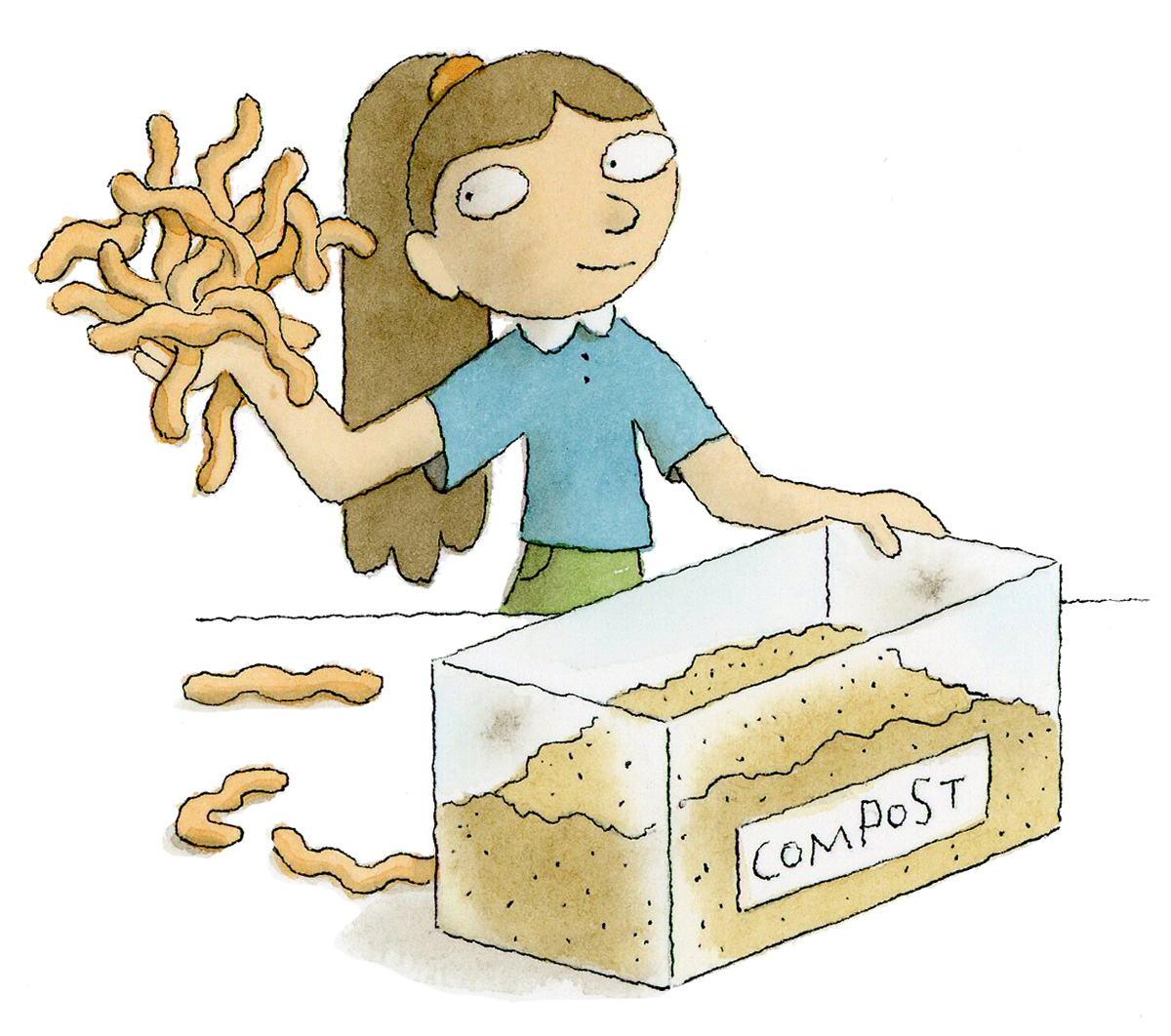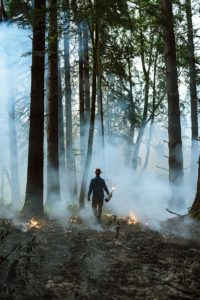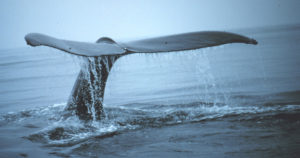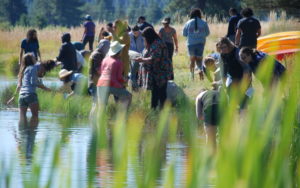
On a recent morning in Joyce Craig’s fifth grade classroom at Henry Haight Elementary in Alameda, students dig with their hands methodically through dirt. The students are divided into groups of four, and each group has its own terrarium, a rectangular box of transparent plastic, on the counter at one side of the classroom. They started the project weeks before, creating their own compost for their terrariums, then adding shredded paper and worms. Today, they check the decomposing mixture for worms. Some groups find two or three, and others find none.
“All of ours have died,” a student with braids tells me cheerfully, twirling the braids in her fingers. “We didn’t make it moist enough, I guess.” But in science, even null findings are useful. The student makes note of this one in her journal.
The groups whose worms survived, meanwhile, draw a crowd. The children spray water to moisten the soil. Then each group, worms or not, receives seeds from Craig—sunflower, wheat or rye—and plants them in the terrariums.
Craig, wearing a camouflage jacket, has a patient demeanor as she walks from table to table, assisting each group. After the lesson, she tells me she uses this project as a way to teach her students about ecosystems. As the students tend their plants and worms, observing what survives and grows and what doesn’t, they learn about where living things get nourishment and also about how each life form depends on, and can’t live without, others. The worms produce waste that feeds the plants. They themselves eat bacteria and fungi that, in turn, live off organic material that originated in plants. It’s the full circle of life—sun, plant, microbe, animal—conveyed in a hands-on, dirt-under-your-fingernails way.
“The kids have to have common experiences with these things before they can understand the written part of it,” Craig tells me. She points to a biology textbook. “This is abstract. This is a story to them. But when they do it and see it first, they get a deeper meaning from it.”
Craig’s class belongs to the pilot phase of a much larger effort called the California Environmental Literacy Initiative. Its goal is to make every child environmentally literate by the time he or she graduates high school. About a dozen school districts—some K through 8 and others K through 12—are currently participating in the pilot phase. If all goes well, the initiative will continue to scale up incrementally over the coming years and then at some point expand exponentially, ultimately to every public school in the state.
Other states have launched similar efforts in recent years. Maryland now requires that high school students complete an environmental literacy program before graduating. Oregon passed an initiative in 2016 that, on a voluntary basis, offers funding for every student to attend a weeklong residential outdoor school between fifth and sixth grade.
And last September, California passed a bill that formally embeds environmental literacy in California’s education code. The bill doesn’t provide funding to school districts for environmental literacy—that must come separately from the Legislature—but it establishes environmental literacy as a long-term priority in the state’s public education system, helping to guarantee, proponents hope, that the effort continues after Tom Torlakson, the current state superintendent of public instruction and a champion of the effort, leaves office.
The initiative has settled on five big principles it hopes to convey to students, including the ideas that people both depend on and influence natural systems. Publishers of school teaching materials have already incorporated these concepts into the state’s new curricula materials for science and history–social science. For example, a fourth-grade standard lesson that asks students to analyze the effects of the Gold Rush now also covers the Gold Rush’s effects on the physical environment. Each school district will adopt these new materials at its own pace. The eventual goal is to embed such concepts in every subject.
The larger environmental literacy effort stems, in part, from a sense among policymakers and educators that going forward, Californians need to understand environmental science the way they understand civics or math—as a deeply ingrained pool of knowledge they can automatically draw on—because they’ll increasingly encounter related issues as voters and citizens. In a crowded, warming world beset by deliberate campaigns of misinformation, the thinking goes, people need to have the education to make informed decisions. Their lives and livelihoods may depend on it.
The project also reflects a more general anxiety in the environmentalist movement. American environmentalism has many roots, but a prominent one grows from the ferment of the 1960s. Those baby boomers are now aging and retiring, and they wonder who will carry the mantle of what they see as hard-fought gains forward, and how to get the next generation interested and involved as the effects of climate change intensify. Part of the answer to that question lies in bridging perceived racial divides.
Historically, the mainstream environmentalist movement has skewed white and affluent. But California is now majority-minority. Over 70 percent of public school students today are nonwhite, compared to around 57 percent 24 years ago. The initiative aims to get all young Californians educated and interested in the environment, but particularly nonwhite students, because it recognizes them as important to the future of healthy, thriving natural systems. “If only a minority of people care about the environment, we’re not likely to be successful,” says Craig Strang, co-chair of the California Environmental Literacy Steering Committee and a founding member of the original task force that dreamed up the idea. “We can’t be successful without finding our intersection with communities of color.”
The original guidelines for the project, called the Blueprint for Environmental Literacy, thus emphasize equity. The aim is to close the historical gaps between affluent schools and low-income schools, majority white schools and majority nonwhite schools, in terms of access to an environmental curriculum, which might include field trips to the redwoods or tidepools—places that help educate students experientially about the biology and ecology of the natural world. These classes are often funded by school PTAs, says Strang. And because donations to a PTA are a function of parents’ affluence, poorer schools often can’t afford these outings. The proposed fix is that every school receive a budget from the school district to help embed environmental literacy into the existing curriculum and to fund outdoor instruction and field trips.
The word “environmental” carries varied connotations for the different people who make up California’s diverse human tapestry. How do you teach environmental literacy in places where people are resistant to the concept? How do you define literacy in a community where livelihoods depend on an environmentally controversial industry like oil refining, timber harvesting, or cattle ranching? For that matter, is it really appropriate or helpful to teach a low-income student living in urban Richmond about the splendors of Yosemite? Or is that student better served learning about the air quality issues that might be exacerbating asthma in his or her city?
In anticipation of these complexities, the Blueprint emphasizes “cultural relevancy,” the idea that what students learn should be relevant to their lives and the places they live. Rather than dictating what should happen in the classroom, those behind the initiative have tried to learn from schools that have already, on their own, implemented environmental literacy-like programs. They host meetings where representatives from school districts currently in the pilot phase can learn from each other’s mistakes and successes, treating those organic efforts as laboratories of experimentation and innovation.

Meet Juanita Chan. In 2014, Chan, who’d taught in the Rialto Unified School District in San Bernardino County for over 10 years, joined the district committee for implementing the Next Generation Science Standards, which had just been adopted by the state the previous year.
Administrators encouraged teachers on the committee to use the new standards “to explore local relevant phenomena,” a phrase Chan remembers hearing repeatedly. She realized that even though she spent her entire childhood in Rialto, she knew very little about the issues affecting the city.
So she began exploring Rialto’s city government and programs. She introduced herself to the mayor. She met the head of the water department. She attended meetings of the Kiwanis club, Neighborhood Watch, and other nonprofits throughout the city. As she spoke with more people, she noticed that they often mentioned the same pressing issues: food deserts contributing to chronic disease, air pollution from the new freeway built right through town.
“I realized that I had lived here this whole time and had no idea any of this was happening,” says Chan. She began asking teachers if they’d heard about these problems. They hadn’t.
In the summer of 2015, she helped organize teacher “staycations,” in which faculty members took trips to places around town affected by environmental problems. They visited the aquifer and learned how certain land use practices had contaminated some of the water with perchlorate, a likely carcinogen. They toured the local grove where the oranges in the school cafeterias came from and heard about the trees afflicted by citrus greening disease.
The teachers returned from these outings inspired to teach their students about the environmental problems around them. They thought up new projects. One class partnered with the local water authority and had students mathematically model water usage, create a conservation calendar, monitor the school’s water bills, and design a landscape that would require little or no irrigation. Other classes designed a garden space to grow fresh vegetables for a local senior center that served a needy population.
When Chan learned about the Blueprint for Environmental Literacy, in 2014, she and her colleagues were just getting their own projects underway. The Blueprint helped the district shift what were still just sporadic lessons to a districtwide initiative, making it more coherent.
“Our language shifted from ‘We’re teaching a new approach to science’ to ‘We’re building environmentally literate students,’” she says.
Over the next few years, Chan saw the new focus on environmentalism revitalize several schools. Two even branded themselves as environmental literacy schools. They built gardens and outdoor classrooms. At one, staff worked with Native American parents to provide presentations during school assembly on Native culture and their relationship to the environment. The other school created a “100-mile club”: students pledged to jog or walk 100 miles outdoors during the year.
Other teachers applied for grants to sponsor environmentally minded projects. One fifth-grade teacher was so inspired after a summer environmental literacy workshop that he signed up for a teacher training course in Yosemite the following summer—and convinced two of his colleagues to do the same.
Generally, the focus stayed local. “We don’t live near the mountains or by the beach. There are no big trees. We have a small creek with water that hardly goes past your ankles. We have shrubs and mice,” Chan told me. “There’s no nature here that anyone would consider necessarily ‘beautiful’ to highlight. So instead, I have to frame environmentalism through asking, ‘What is there to love in my community?’”
In Chan’s view, a successful environmental literacy program would be one where students from this community become leaders and help solve the many problems plaguing their own communities.
“I don’t want someone to come and solve our problems,” she explains. “The best people to solve these issues are the ones experiencing it firsthand.”
When Craig Strang and his colleagues were developing the Blueprint, they surveyed schools around the state in an attempt to better understand what teachers had already discovered was helpful in teaching environmental literacy. One finding jumped out. In the most successful efforts, schools generally partnered with community organizations, like museums and aquariums. So Strang began reaching out to local organizations, both to seek feedback on how to implement the Blueprint and to compile a list of possible partners for the future. That turned out to be a learning experience in its own right.
Strang knew that the mainstream environmental movement tended to be white, so he wasn’t sure that environmentally oriented organizations actually existed in nonwhite communities. But he discovered that contrary to his own assumptions, organizations that tackled pressing environmental issues did exist. They just didn’t call what they were doing environmentalism.
“Many of these groups ended up telling us, ‘We don’t think of ourselves as an environmental education organization. We think of ourselves as a clean water and air organization, as a transportation organization, as a safe bicycle pathways organization,’” Strang recalls. “Instead of labeling it ‘environmental,’ they considered their work about health, poverty, and social justice.”
“A lot of them told me, ‘We don’t want to join your environmental education club,’” Strang says. They argued that rather than them conforming to a narrow definition of environmentalist, educators needed to expand their idea of what environmentalist partnerships could look like.
Some told Strang that defining themselves as “environmentalist” could cause them to lose perceived relevance in their community and even funding because they’d presented themselves as social justice or anti-poverty organizations when applying for grants. Strang sensed that underneath these objections lay painful experiences from previous interactions with the conservation and environmental movements. The conservation movement began, he notes, in the 19th century and was widely conceived as an effort to protect wild places for rich white people to hunt, vacation, and recreate in. And environmental organizations in the ’60s, ’70s, and ’80s expressly did not concern themselves with issues affecting people living in urban settings, he says. He felt he was bumping up against the legacy of a long and complicated history of implicit bias, exclusion, and overt racism.
“A lot of them told me, ‘We don’t want to join your environmental education club,’” Strang says. They argued that rather than them conforming to a narrow definition of environmentalist, educators needed to expand their idea of what environmentalist partnerships could look like.
It was a “powerful and humbling” learning experience, Strang says, to learn that many of the very communities he was so anxious to rope into the literacy effort had already established their own programs, and that he, an educator in the field for decades, had missed this innovation.
“There are natural alliances that can be mutually beneficial,” he says, “but they haven’t always come together.”
And what about red-state California? These days, California is cast as a blue bastion, a bulwark against Trumpism, but in fact, it’s a big, varied state and its hinterlands tend to be more conservative than its coastal areas. Some parents in these more right-leaning parts of the state may view the word “environmental” with suspicion and object to their kids participating in any state-sponsored environmental literacy program.
Those seeking to launch such programs in these parts might learn a thing or two from Rob Wade. Twenty-three years ago, he started an environmental literacy program in rural and predominantly white unified school district of Plumas County. He wasn’t from the mountainous region—he grew up in the Central Valley—and parents initially viewed him with skepticism, he says. Many worked in the timber industry, historically a target of environmentalist ire; they thought that he was trying to indoctrinate their children.
He won them over with a campaign of extreme transparency. He invited parents to classes and outings and emphasized that he wasn’t trying to inculcate any point of view in their children. Rather, he was giving kids the platform to get to know and love the wild landscape they inhabited, through science. This approach has worked over the years as the program has expanded to K through 12 classrooms, says Wade, now the outdoor science coordinator for the district. It’s even successful for sensitive topics like climate change. He works hard not to “front-load” the issue, he says, meaning that he never starts with whether climate change is good or bad. Instead, he has the children focus on the science and what it indicates. “The kids get to come to their own conclusions,” he says.

However innovative and ambitious the California Environmental Literacy Initiative may be, it faces the same hurdles any new educational effort faces. Chief among them: it needs funding, and it needs to get teachers on board.
“Teachers are humans, with lives outside of school,” Kimberly Valentino, the assistant principal of Haight Elementary, told me. “They don’t necessarily want to spend six hours after work figuring out how they’re going to mix this into their math and science curriculum.”
But environmental literacy is already baked into the state’s new science and history–social science curricula material, so teachers in districts that adopt the new teaching materials shouldn’t have to worry much about extra work.
Still, that may not be teachers’ perception. “We hesitate to call it a different subject or initiative because then teachers worry about what they’ll have to ‘give up’ to make time,” says Craig, the fifth grade teacher in Alameda.
Remember, they are an exotic species in the Western United States, and are rapidly increasing their geographic range and range of habitats. Are they outcompeting or excluding native species in the process? How would we know? We have done almost nothing to monitor changes in the assemblage of mushroom species in areas before and and after the incursion of death caps.
Further Reading
Pringle et al, “The ectomycorrhizal fungus Amanita phalloides was introduced and is expanding its range on the west coast of North America,” Molecular Biology 2009
Lockhart et al, “Simultaneous emergence of multidrug-resistant Candida auris on 3 continents confirmed by whole-genome sequencing and epidemiological analyses,” Clinical Infectious Diseases 2017
Battalani et al, “Aflatoxin B1 contamination in maize in Europe increases due to climate change,” Scientific Reports 2016
CALIFORNIA’S ENVIRONMENTAL PRINCIPLES
As part of the California Environmental and Education Initiative (EEI), the five following principles — as well as a series of supporting concepts — are required by law to be incorporated into textbooks and instructional materials adopted by California. The principles undergird all EEI curriculum. Read more about the EEI principles and concepts at californiaeei.org
- People depend on natural systems
- People influence natural systems
- Natural systems change in ways that people benefit from and can influence
- There are no permanent or impermeable boundaries that prevent matter from flowing between systems
- Decisions affecting resources and natural systems are complex and involve many factors
And other forces in the classroom may be working against the program’s success, Craig notes. One is standardized testing. California tests students for math and English more often than it tests for science and history, so teachers sometimes de-prioritize the latter—the very subjects where environmental literacy is most easily integrated.
“They know their kids are not being tested on it, so it becomes one of those things that goes to the back burner,” Craig says. “We get pulled in two different directions.” She thinks the emphasis on testing for math and English could inadvertently cause environmental literacy to fall through the cracks.
“I know that teaching this is the right thing to do,” she adds. “But I also know that I’m going to be looked at as a teacher based on these testing scores. That’s my reality.”
California also has a long-standing achievement gap: scores released in October showed that proficiency rates in English and math for white and Asian students are double, and sometimes triple, the rates of low-income Latino and black students. Some estimate that it could take 30 years for black and Latino students to catch up. If California hasn’t yet managed to equitably teach students basic literacy and math, asked several people I interviewed, how can it begin to tackle more complex issues like environmental literacy?
Juanita Chan doesn’t see this disparity as problematic, but as an opportunity. Environmental literacy can be the vehicle for more effective learning of math and science, she argues.
“What ends up happening often in underserved communities is that teachers emphasize only basic computational understanding, devoid of context,” says Chan. “There has to be some instruction on how those pieces are connected.” Environmental literacy can provide that critical context. “It answers, ‘Why do I care about the numbers? Why do I care to read? Because it is related to something I know,’” she explains.
In fact, based on experiences like Chan’s, Ten Strands, a nonprofit that helped develop the Blueprint and now supports schools as they roll out the program, created a dedicated environmental justice equity group that includes partners from both the health sector and the environmental justice movement.
“The thing that seems to have the most impact on the young people we’ve worked with is when they can use environmental literacy as a way to show up as young activists in their communities,” Ten Strands CEO Karen Cowe notes.
But questions about funding remain. For the initiative to take root in schools across the state, Cowe adds, the state must provide continual support. In 2017, the state allotted $4 million to support environmental literacy—an amount Strang calls “chump change.” And that was a one-off event. No law yet requires the state to continue funding the initiative.
“We don’t believe that we can drop in a little bit of influence and it can change overnight. It’s a long-term commitment,” Cowe says. “The government in California needs to want this. And that wanting needs to flow throughout the system.”
Strang, Cowe, and their colleagues plan to approach the state Legislature during the next session to seek ongoing funding not just for implementation, but also for a messaging and communication campaign that targets leaders in the education field and shapes discourse around the effort. In the meantime, the initiative is being kept afloat in part by private funding, which flows through Ten Strands.
Then there’s the question of how to measure success without any formal assessment focused specifically on environmental literacy. Students will of course take tests on science and history–social science, which now contains environmental literacy material. But how will teachers really know that kids have become environmentally literate? And what might that look like, anyway?
“I’m giving them the opportunity to get information in as many ways as possible. But I cannot guarantee, even by giving a test, that they have internalized it and made it a part of them,” Craig says. “I won’t know that until they’re grown up.”
The last day I visited Craig, she had just met with teachers about a student who was having problems. The student’s parents are undocumented residents, and he has struggled to focus on academics because he’s worried about being separated from his family. It’s been an issue ever since the 2016 election of Donald Trump, Craig notes. Many of her students and their families come to school scared, genuinely believing they will soon be deported. Regardless of what educational policies the state focuses on, she says, issues outside the classroom greatly affect her students’ ability to learn. And she considers these issues “environmental education” as well.
“That’s his environment. That’s what he owns,” she says. “I have to address that too.”




